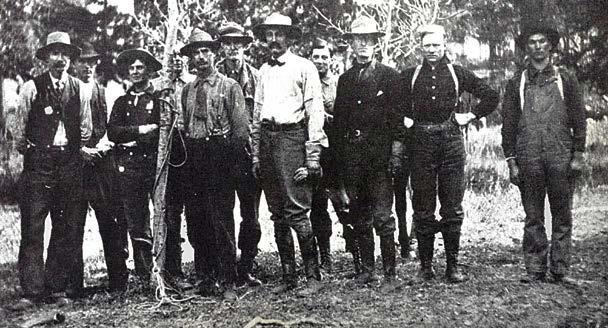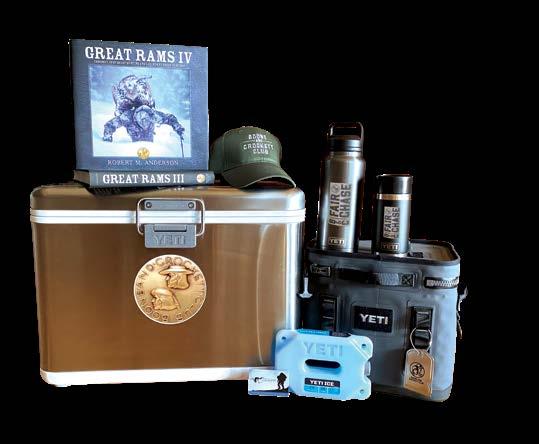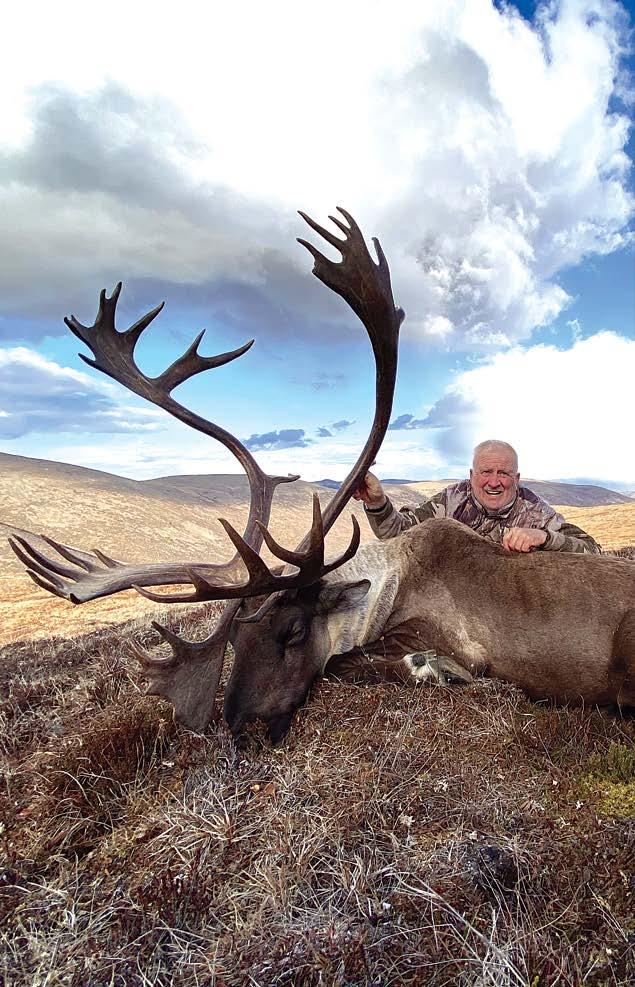
10 minute read
ACCURATE HUNTER | Admiring the Shot
PROFESSIONAL MEMBER Photos Courtesy of Author
ACCURATE ACCURATE HUNTER HUNTER
Advertisement
ADMIRING THE SHOT
This was Boddington’s shooting position when he took his Wyoming bighorn. Dead steady, only one shot was needed. Even so, it’s essential to maintain your position and be ready to shoot again if needed.
Make the first as good as you can…and be ready for the next!


We’d had a tough week in northern
Alberta. Not enough snow, not cold enough for moose, and they weren’t moving. On the last day we came around a little bend and there stood an “okay” bull in a clear-cut. My buddy John Stucker saw him first, and it was his shot. John bailed out, got steady, and took the 240-yard shot with his .280. The bull took the bullet hard, and the hit looked good. Our outfitter immediately said, “Great shot, don’t shoot him again.”
On any outfitted hunt, the best advice I can offer is: listen to your guide. After all, you’re paying hardearned cash for expertise. If you’ve done your homework, you’re also paying for local knowledge and good country for the game you seek. So, generally speaking, paying attention is solid advice. Five years (and several shared hunts) later, Stucker and I were sitting around a campfire in Montana, reliving past adventures. John said, “The one piece of advice I will never follow again is when a guide tells me not to shoot again!” Luckily, we got that moose at freezing dark, and built a roaring fire so we could alternate warming our hands while doing the chores. Some might argue that the .280 is a bit light for a bull moose, but that’s not my experience, and John had used a good, heavy bullet. In my opinion, plenty of gun…if the bullet is well-placed.
ABOVE: A Colorado bull, taken with a single 200-grain bullet from a .338 Marlin Express. A bull elk is about three times bigger than a large buck deer, and much tougher. Additional shots aren’t always (or often) necessary…but it’s essential to be ready.
BELOW: A big Alaska brown bear, taken with a .375 H&H. Regardless of cartridge used, in Boddington’s experience, one-shot kills are rare with big bears. Even if the first shot is perfectly placed, all bears are tough. The bigger, the tougher!

AH


LEFT: This Kansas “cull” buck dropped so fast to a .257 Roberts that Boddington suspected he must have slipped high and hit the spine. Not, the shot was centered on the shoulder, but animals don’t often drop in their tracks to body shots. Better stay ready! RIGHT: With virtually all quadrupeds, Boddington mentally divides the animal into horizontal thirds. Ideal shot placement, either on or behind the shoulder, is the top of the bottom third… but never more than halfway up from the brisket/belly line.
I agreed the shot looked perfect, right on the shoulder— except it wasn't perfect. The bullet had slipped low, creasing the bottom of the heart. John had immediately worked his bolt, gotten back on the moose and was ready to fire again…but he didn’t. On my first African hunt, my excellent Kenya professional hunter, Willem van Dyk, calm and steadying, taught me a lot. This one has stayed with me. “Americans,” he said, “are especially bad about ‘admiring the shot.’” With mostly unrestricted access to the full array of sporting firearms, wide choices in ammunition, and with handloading a unique and popular American pastime, we tend to be fixated on extreme accuracy. This is not a bad thing. Varmint hunting is also a uniquely American pastime, and there’s no such thing as too much accuracy for small rodents such as prairie dogs. The growing interest in long-range shooting also begs for all the accuracy one can get. We pride ourselves on the legacy of being a “nation of riflemen,” one shot, one kill. Sadly, I’m not convinced this remains true (if it ever was), but it’s an ethos that’s hard to escape. We spend much time on the bench shooting teeny, tiny groups. For all too many of us, this is the only “practice” we take. In the field, we set up with infinite care, sometimes dithering overly long to address a target that, after all, isn’t especially small; a whitetail deer has a vital zone the size of a basketball! In these pages, I try to avoid using examples from other continents. However, with long seasons and huge variety, African professional hunters see a great deal of game shot (and shot at). A common complaint isn’t raw marksmanship, but taking too much time getting the shot off. This, along with “admiring the shot.” Experienced European hunters, with a long tradition of driven game (that they practice for), tend to be faster, and better at repeat shots. We set up as carefully as possible, wait until everything is just right, and then press the trigger for that perfect shot. So far, just fine. Rushing a shot is a terrible mistake, but over-studying can be as well. The window to take a shot is often narrow. Just how perfect things need to be depends on distance, size of animal, and conditions. So, in the time you think you have, you get ready and make that first shot as good as possible. Then comes a common error: You come out of recoil, looking through or over the scope to see what happened. That is “admiring the shot.” Whether perfect or not, that shot is gone and can’t be called back. What happens next is up to you (and the situation you face), but you should immediately make ready to shoot again. The variations are infinite. Absent brain or spine shots, we all know that it’s impossible to consistently drop animals in their tracks; a short final run is normal. No, I don’t always shoot again. It depends on how certain I am, and also the animal’s reaction upon receiving the bullet. Unfortunately, correctly calling shots and judging reaction takes experience. Despite many years of it, neither is perfect science! Even shots that you believe to be near-perfect can go astray (bad cartridge, bullet failure, stray puff of breeze, ranging error, unseen animal movement, and so much more). And, some animals are more tenacious than others. I’m not suggesting one should routinely fire again! Often, a second shot is impossible: Brush, terrain, or other animals get in the way too quickly. For sure, you can’t shoot again unless you have a clear shot and you’re absolutely certain you’re on the same animal! If an animal is still up after a first shot it’s always a judgment call as to whether to shoot again or not, and the call must be made instantly. Here’s the thing: if a second is possible, safe, and you don’t take it, you’re banking on at least three things. First, the shot went exactly where you wanted it. Second, you correctly viewed the animal’s angle and presentation. Third, you chose a proper bullet for the game…and it performed as it was supposed to! My own most prevalent aiming error is to shoot a bit high. I think this is especially common because high grass or low brush may obscure the belly line, so you aren’t seeing as much shoulder as you think you are. Mentally, I divide an animal into horizontal thirds. The most ideal shot placement is usually the top of the bottom third. So, with a broadside presentation: ideal bullet placement is one-third up from the brisket/belly line, either on the center of the shoulder for a top-of-heart shoulder shot, or following the rear line of the on foreleg for a lung shot. Halfway up is still okay, but above that you’re getting into the top of the lungs or that “no man’s land” between the lungs and the spine. As a friend likes to say: “There’s not much up there.”


LEFT: Donna Boddington, practicing on sticks with her MGA .270. At every range session she’ll do at least some practice with a full magazine, firing multiple shots. RIGHT: Brad Jannenga and Boddington with a nice Arizona Coues' whitetail, taken with a Ruger No. 1 single-shot in .280 Ackley Improved. The single-shot is slower than any repeater, but with practice reloading is usually fast enough if a second shot is needed. Boddington missed this buck with his first shot, reloaded quickly, and came through with his second shot.
Very bad form on the SAAM range! Boddington is working his bolt, but he’s come completely off the rifle… he is “admiring his shot!”
American hunters prefer the behind-the-shoulder lung shot because it destroys little edible meat and offers the largest target. African hunters consistently prefer the shoulder shot, believing breaking at least one shoulder is likely to bring the animal down more quickly. With either shot, a short final run is likely. In my experience, the shoulder shot is somewhat more likely to drop an animal in its tracks, especially if the bullet penetrates through the chest cavity and also breaks the opposite shoulder. Occasionally, a central lung shot will put an animal straight down. However, when an animal drops instantly to any heart/lung shot I’m immediately suspicious, wondering if I’ve slipped high and hit the spine…or close to it. A near-miss to the spine, either above or below, will often put an animal straight down. Absent actually breaking the spine, the shock may wear off in a few seconds, or it might take several minutes. Then the animal will be up and gone, leaving little blood, often never to be seen again. When any animal goes down immediately, I stay ready to shoot again if the animal is visible…or get there as quickly as I can and approach with caution. Many experienced hunters have stories about animals so hit that escaped; mine was the biggest greater kudu I ever shot at! If there’s any movement for more than a few seconds, I usually shoot again. As always, that’s a judgment call, but the point is to immediately make ready to shoot again…so you can make that decision. Do not dither around, “admiring the shot” until it’s too late! The best way to prepare is to do at least some of your practice from field positions with a full magazine, firing multiple shots and working the action until it becomes second nature. Obviously, some actions are faster than others, but not by much—and not enough to preclude a second shot if necessary. The exception is the single-shot; it’s essential to practice reloading rapidly, and always have additional cartridges at hand. I love single-shot rifles and hunt with them a lot. The ethic of the one shot is seductive and tends to make me extra careful with that one shot. That’s to the good, but knowing I have just that one sure chance also tends to make me slow on the reload and promotes “admiring the shot.” Again, practice is the key. I’ve made many one-shot kills with single-shot rifles, but I’ve also missed and needed to shoot again. They are definitely slower than any repeater, but I can’t recall an instance where I’ve needed a second shot and failed to take an animal because I couldn’t get a single-shot reloaded fast enough. Just last fall, I shot at a nice Coues’ deer on my sonin-law’s Arizona ranch with a Ruger No. 1 in .280 Ackley Improved. It was a 250-yard steep downhill shot. I expected the buck to fold up, and was dumbfounded when my bullet went right over the top! Fortunately, I had cartridges on my belt, reloaded quickly, and connected with the next shot. Sometimes you have to shoot more than once, and you can’t do that while you’re admiring your first shot! n










